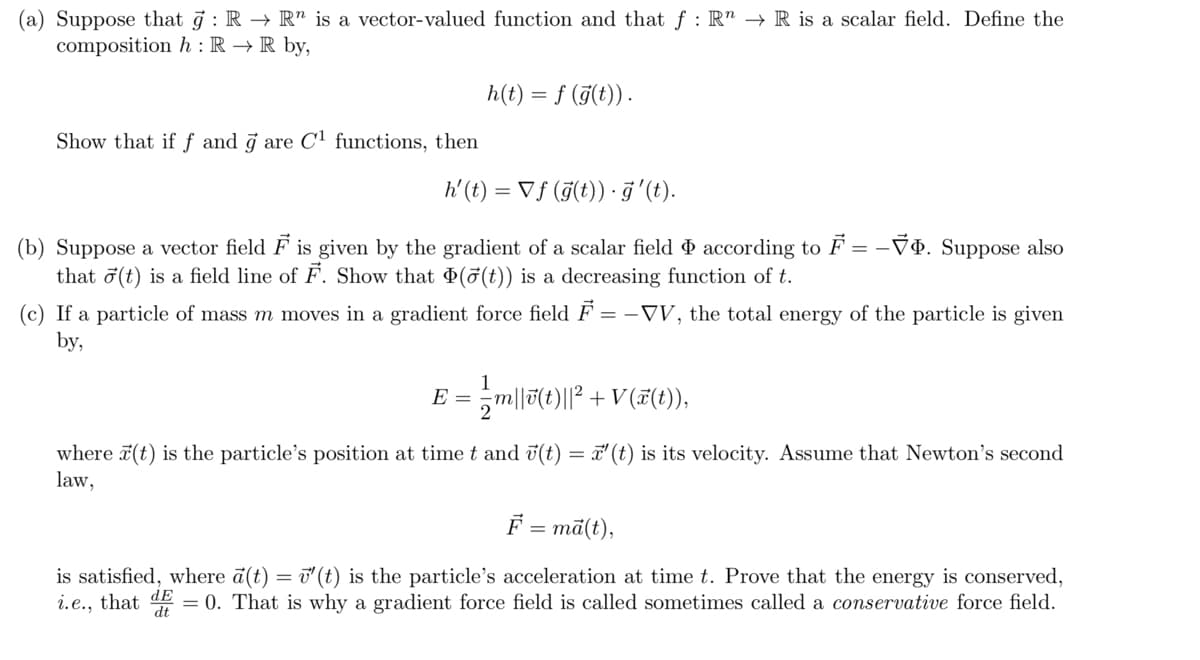(a) Suppose that g : R → R" is a vector-valued function and that f : R" → R is a scalar field. Define the composition h : R → R by, h(t) = f (j(t)). Show that if f and g are C1 functions, then h' (t) = Vf (7(t)) · ĝ'(t). (b) Suppose a vector field F is given by the gradient of a scalar field & according to F = -V¢. Suppose also that o(t) is a field line of F. Show that (ỡ(t)) is a decreasing function of t. (c) If a particle of mass m moves in a gradient force field F = -VV, the total energy of the particle is given by, E = m||7(t)||² + V(#(t)), where 7(t) is the particle's position at time t and ü(t) = x'(t) is its velocity. Assume that Newton's second law, F = mã(t), is satisfied, where a(t) = (t) is the particle's acceleration at time t. Prove that the energy is conserved, i.e., that dE = 0. That is why a gradient force field is called sometimes called a conservative force field.
(a) Suppose that g : R → R" is a vector-valued function and that f : R" → R is a scalar field. Define the composition h : R → R by, h(t) = f (j(t)). Show that if f and g are C1 functions, then h' (t) = Vf (7(t)) · ĝ'(t). (b) Suppose a vector field F is given by the gradient of a scalar field & according to F = -V¢. Suppose also that o(t) is a field line of F. Show that (ỡ(t)) is a decreasing function of t. (c) If a particle of mass m moves in a gradient force field F = -VV, the total energy of the particle is given by, E = m||7(t)||² + V(#(t)), where 7(t) is the particle's position at time t and ü(t) = x'(t) is its velocity. Assume that Newton's second law, F = mã(t), is satisfied, where a(t) = (t) is the particle's acceleration at time t. Prove that the energy is conserved, i.e., that dE = 0. That is why a gradient force field is called sometimes called a conservative force field.
Algebra and Trigonometry (MindTap Course List)
4th Edition
ISBN:9781305071742
Author:James Stewart, Lothar Redlin, Saleem Watson
Publisher:James Stewart, Lothar Redlin, Saleem Watson
Chapter9: Vectors In Two And Three Dimensions
Section9.FOM: Focus On Modeling: Vectors Fields
Problem 4P: 1-6 Sketch the vector field F by drawing a diagram as in figure 3. F(x,y)=(xy)i+xj
Related questions
Question

Transcribed Image Text:(a) Suppose that g : R → R" is a vector-valued function and that f : R" → R is a scalar field. Define the
composition h : R → R by,
h(t) = f (j(t)).
Show that if f and j are Cl functions, then
h' (t) = Vƒ (F(t)) · ĝ'(t).
(b) Suppose a vector field F is given by the gradient of a scalar field & according to F = -VÐ. Suppose also
that ở(t) is a field line of F. Show that (5(t)) is a decreasing function of t.
(c) If a particle of mass m moves in a gradient force field F = -VV, the total energy of the particle is given
by,
E = ,m||7(t)||² + V(#(t)),
where 7(t) is the particle's position at time t and ü(t) = 7' (t) is its velocity. Assume that Newton's second
law,
F = mā(t),
is satisfied, where a(t) = i'(t) is the particle's acceleration at time t. Prove that the energy is conserved,
i.e., that dE = 0. That is why a gradient force field is called sometimes called a conservative force field.
Expert Solution
This question has been solved!
Explore an expertly crafted, step-by-step solution for a thorough understanding of key concepts.
Step by step
Solved in 3 steps with 2 images

Recommended textbooks for you

Algebra and Trigonometry (MindTap Course List)
Algebra
ISBN:
9781305071742
Author:
James Stewart, Lothar Redlin, Saleem Watson
Publisher:
Cengage Learning

Algebra and Trigonometry (MindTap Course List)
Algebra
ISBN:
9781305071742
Author:
James Stewart, Lothar Redlin, Saleem Watson
Publisher:
Cengage Learning